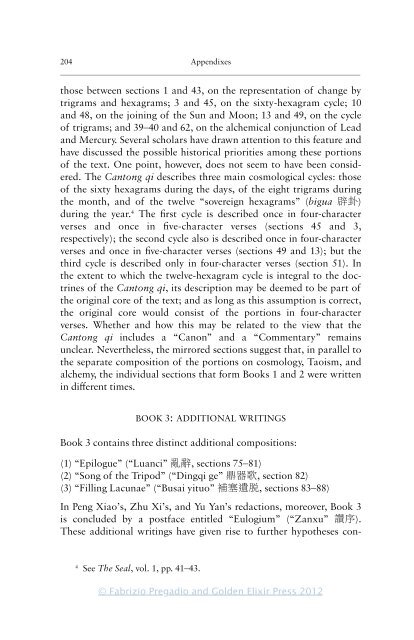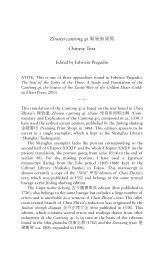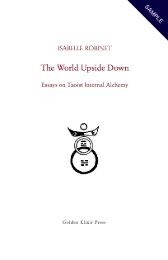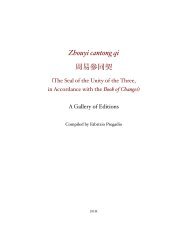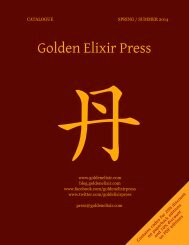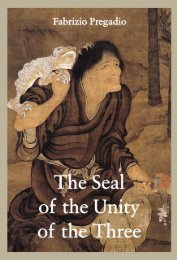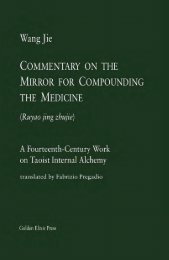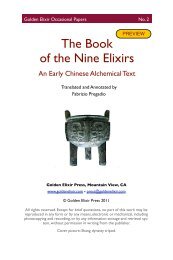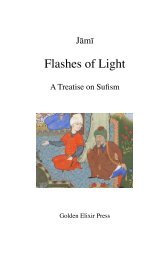The Seal of the Unity of the Three â Vol. 2 - The Golden Elixir
The Seal of the Unity of the Three â Vol. 2 - The Golden Elixir
The Seal of the Unity of the Three â Vol. 2 - The Golden Elixir
- No tags were found...
You also want an ePaper? Increase the reach of your titles
YUMPU automatically turns print PDFs into web optimized ePapers that Google loves.
204 Appendixes<br />
—————————————————————————————————————————<br />
those between sections 1 and 43, on <strong>the</strong> representation <strong>of</strong> change by<br />
trigrams and hexagrams; 3 and 45, on <strong>the</strong> sixty-hexagram cycle; 10<br />
and 48, on <strong>the</strong> joining <strong>of</strong> <strong>the</strong> Sun and Moon; 13 and 49, on <strong>the</strong> cycle<br />
<strong>of</strong> trigrams; and 39–40 and 62, on <strong>the</strong> alchemical conjunction <strong>of</strong> Lead<br />
and Mercury. Several scholars have drawn attention to this feature and<br />
have discussed <strong>the</strong> possible historical priorities among <strong>the</strong>se portions<br />
<strong>of</strong> <strong>the</strong> text. One point, however, does not seem to have been considered.<br />
<strong>The</strong> Cantong qi describes three main cosmological cycles: those<br />
<strong>of</strong> <strong>the</strong> sixty hexagrams during <strong>the</strong> days, <strong>of</strong> <strong>the</strong> eight trigrams during<br />
<strong>the</strong> month, and <strong>of</strong> <strong>the</strong> twelve “sovereign hexagrams” (bigua 辟 卦 )<br />
during <strong>the</strong> year. 4 <strong>The</strong> first cycle is described once in four-character<br />
verses and once in five-character verses (sections 45 and 3,<br />
respectively); <strong>the</strong> second cycle also is described once in four-character<br />
verses and once in five-character verses (sections 49 and 13); but <strong>the</strong><br />
third cycle is described only in four-character verses (section 51). In<br />
<strong>the</strong> extent to which <strong>the</strong> twelve-hexagram cycle is integral to <strong>the</strong> doctrines<br />
<strong>of</strong> <strong>the</strong> Cantong qi, its description may be deemed to be part <strong>of</strong><br />
<strong>the</strong> original core <strong>of</strong> <strong>the</strong> text; and as long as this assumption is correct,<br />
<strong>the</strong> original core would consist <strong>of</strong> <strong>the</strong> portions in four-character<br />
verses. Whe<strong>the</strong>r and how this may be related to <strong>the</strong> view that <strong>the</strong><br />
Cantong qi includes a “Canon” and a “Commentary” remains<br />
unclear. Never<strong>the</strong>less, <strong>the</strong> mirrored sections suggest that, in parallel to<br />
<strong>the</strong> separate composition <strong>of</strong> <strong>the</strong> portions on cosmology, Taoism, and<br />
alchemy, <strong>the</strong> individual sections that form Books 1 and 2 were written<br />
in different times.<br />
BOOK 3: ADDITIONAL WRITINGS<br />
Book 3 contains three distinct additional compositions:<br />
(1) “Epilogue” (“Luanci” 亂 辭 , sections 75–81)<br />
(2) “Song <strong>of</strong> <strong>the</strong> Tripod” (“Dingqi ge” 鼎 器 歌 , section 82)<br />
(3) “Filling Lacunae” (“Busai yituo” 補 塞 遺 脫 , sections 83–88)<br />
In Peng Xiao’s, Zhu Xi’s, and Yu Yan’s redactions, moreover, Book 3<br />
is concluded by a postface entitled “Eulogium” (“Zanxu” 讚 序 ).<br />
<strong>The</strong>se additional writings have given rise to fur<strong>the</strong>r hypo<strong>the</strong>ses con-<br />
4<br />
See <strong>The</strong> <strong>Seal</strong>, vol. 1, pp. 41–43.<br />
© Fabrizio Pregadio and <strong>Golden</strong> <strong>Elixir</strong> Press 2012


